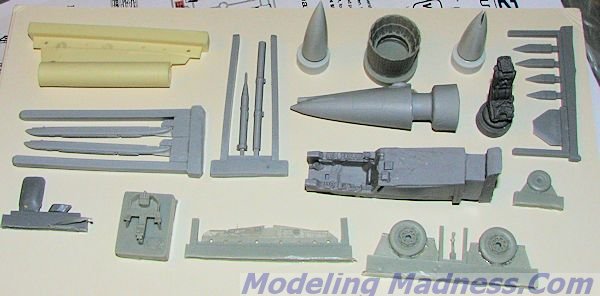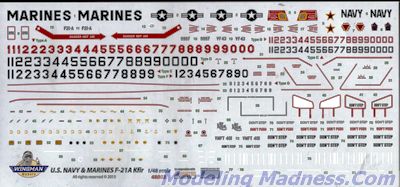
| KIT #: | 48003 |
| PRICE: | 55.00 Euros from www.wingmanmodels.com |
| DECALS: | Dozens of options |
| REVIEWER: | Scott Van Aken |
| NOTES: | Includes resin, photo etch and masks |

| HISTORY |
Twenty-five modified Kfir C.1s were leased to the United States Navy and the United States Marine Corps from 1985 to 1989, to act as adversary aircraft in dissimilar air combat training (DACT). These aircraft, designated F-21A Kfir, had narrow-span canard foreplanes and a single small rectangular strake on either side of the nose which considerably improved the aircraft's maneuverability and handling at low speeds.
The 12 F-21 aircraft leased to the U.S. Navy, painted in a three-tone blue-gray "ghost" scheme, were operated by Fighter Squadron 43 (VF-43), based at NAS Oceana, Virginia. In 1988, they were returned and replaced by the F-16N. The 13 aircraft leased to the U.S. Marine Corps were operated by Marine Fighter Training Squadron 401 (VMFT-401), a 4th Marine Aircraft Wing/Marine Corps Reserve squadron at Marine Corps Air Station Yuma, Arizona. In addition to the blue-gray painted aircraft, the USMC also had some F-21s painted in Israeli colors and desert "flogger" schemes (named because they were to represent the schemes often worn by Warsaw Pact MiG-23 "Floggers". The Kfir was utilized because they both shared the common characteristic of being very fast (Mach 2+) and fast-accelerating aircraft with relatively poor maneuverability. The MiG-23 was targeted as the "enemy" aircraft because at this time the MiG-23 was being introduced in very large numbers, and was a very capable aircraft compared to earlier Soviet types. These USMC F-21 aircraft were replaced by F-5E aircraft when the F-21s were returned in 1989 (although this left the training units without any aircraft capable of accurately simulating the Mach 2+ and fast-accelerating MiG-23).
Kfirs are also used by the US firm Airborne Tactical Advantage Company, also known as ATAC, a civilian defense contractor that provides tactical adversary aircraft services to the US military. ATAC provides airborne tactical training, threat simulation, and research & development. ATAC's corporate headquarters and primary operating location is located at Patrick Henry International Airport in Newport News, VA, with additional permanent operating locations at US Naval Air Stations and Marine Corps Air Stations in California, Nevada, Hawaii and Japan. ATAC also operates the Saab 35 Draken, the McDonnell Douglas A-4 Skyhawk and the Hawker Hunter F58. On March 6, 2012, an ATAC Kfir, FAA registration N404AX, crashed while landing at NAS Fallon, Nevada after a flight supporting the Naval Strike and Air Warfare Center. The pilot, retired USN Captain Carroll "Lex" LeFon, was fatally injured.
| THE KIT |
 For those of you not familiar with Wingman Models, what they have done is combine kits from Kinetic, resin from IsraCast, metal bits from Master, and decals from Cartograf to produce what are called Super Kits. This appellation is appropriate as the kit provides everything you'll need to make the best model of the subject that can be produced. No need to buy anything extra as it is all there in the box.
For those of you not familiar with Wingman Models, what they have done is combine kits from Kinetic, resin from IsraCast, metal bits from Master, and decals from Cartograf to produce what are called Super Kits. This appellation is appropriate as the kit provides everything you'll need to make the best model of the subject that can be produced. No need to buy anything extra as it is all there in the box.
The kit starts with the Kinetic offering for all the plastic bits. This kit is nicely molded in the standard of the day when we get kits from China with engraved panel lines and engraved rivet surface detailing. Kinetic offers all the parts for not only an F-21A, but also for an early and late IAF Kfir. As such, there are parts that are not required provided on the sprues.
 What Wingman does is provide a lot of additional resin bits to replace those in the kit as resin is able to capture finer detail much better than what most injected plastic offers. Included in all the resin is a new nose, a new cockpit that includes the nose gear well, new bang seat, instrument panel, inner fuselage panels, and control stick. Also included are new missile rails and one of those ACM sensors that fits on them. A new centerline fuel tank with pylon is provided. This construct has an additional resin nose and tail cap along with resin fins. This item was not always carried so you do have the option of leaving it off. New resin wheels for the main and nose gear are provided along with some new lower nose antennas.
What Wingman does is provide a lot of additional resin bits to replace those in the kit as resin is able to capture finer detail much better than what most injected plastic offers. Included in all the resin is a new nose, a new cockpit that includes the nose gear well, new bang seat, instrument panel, inner fuselage panels, and control stick. Also included are new missile rails and one of those ACM sensors that fits on them. A new centerline fuel tank with pylon is provided. This construct has an additional resin nose and tail cap along with resin fins. This item was not always carried so you do have the option of leaving it off. New resin wheels for the main and nose gear are provided along with some new lower nose antennas.
 There is not a ton of photo etch provided, but what is offered is useful. There are two small frets, one of which is not shown which has some bits for the bang seat. The one shown has reinforcement plates for the small canards, an end plate for the ACM sensor and fin VOR antennas. Master provides a metal nose probe and AOA probe. A set of canopy and wheel masks is also part of the package.
There is not a ton of photo etch provided, but what is offered is useful. There are two small frets, one of which is not shown which has some bits for the bang seat. The one shown has reinforcement plates for the small canards, an end plate for the ACM sensor and fin VOR antennas. Master provides a metal nose probe and AOA probe. A set of canopy and wheel masks is also part of the package.
 Instructions are quite well done showing what modifications may be required to properly model the F-21A. The Cartograf decals provide common data markings and enough unique markings to model any F-21A used by the Navy or Marines. Six markings options are provided in the placement guide, but you can just as easily model any plane for which you have a photo. I have darkened the sheet so the white bits will show more clearly.
Instructions are quite well done showing what modifications may be required to properly model the F-21A. The Cartograf decals provide common data markings and enough unique markings to model any F-21A used by the Navy or Marines. Six markings options are provided in the placement guide, but you can just as easily model any plane for which you have a photo. I have darkened the sheet so the white bits will show more clearly.
| CONCLUSIONS |
In all, this makes for an outstanding kit that provides everything you will need to make a superlative model. No need for any aftermarket on this one. These are made in small runs so I would suggest picking yours up soon to avoid disappointment.
| REFERENCES |
http://en.wikipedia.org/wiki/IAI_Kfir September 2014
Thanks to Wingman models for the preview kit. You can get yours today at this link. Also available at Hannants and LuckyModel.
If you would like your product reviewed fairly and fairly quickly, please contact the editor or see other details in the